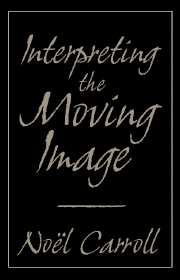Book contents
- Frontmatter
- Contents
- Foreword: Through Carroll's Looking Glass of Criticism
- Introduction
- 1 The Cabinet of Dr. Kracauer
- 2 Entr'acte, Paris and Dada
- 3 The Gold Rush
- 4 Keaton: Film Acting as Action
- 5 Buster Keaton, The General, and Visible Intelligibility
- 6 For God and Country
- 7 Lang, Pabst, and Sound
- 8 Notes on Dreyer's Vampyr
- 9 King Kong: Ape and Essence
- 10 Becky Sharp Takes Over
- 11 Interpreting Citizen Kane
- 12 The Moral Ecology of Melodrama: The Family Plot and Magnificent Obsession
- 13 Mind, Medium, and Metaphor in Harry Smith's Heaven and Earth Magic
- 14 Welles and Kafka
- 15 Nothing But a Man and The Cool World
- 16 Identity and Difference: From Ritual Symbolism to Condensation in Anger's Inauguration of the Pleasure Dome
- 17 Text of Light
- 18 Joan Jonas: Making the Image Visible
- 19 Introduction to Journeys from Berlin/1971
- 20 The Future of Allusion: Hollywood in the Seventies (and Beyond)
- 21 Back to Basics
- 22 Amy Taubin's Bag
- 23 Herzog, Presence, and Paradox
- 24 Film in the Age of Postmodernism
- Notes
- Index
3 - The Gold Rush
Published online by Cambridge University Press: 05 June 2012
- Frontmatter
- Contents
- Foreword: Through Carroll's Looking Glass of Criticism
- Introduction
- 1 The Cabinet of Dr. Kracauer
- 2 Entr'acte, Paris and Dada
- 3 The Gold Rush
- 4 Keaton: Film Acting as Action
- 5 Buster Keaton, The General, and Visible Intelligibility
- 6 For God and Country
- 7 Lang, Pabst, and Sound
- 8 Notes on Dreyer's Vampyr
- 9 King Kong: Ape and Essence
- 10 Becky Sharp Takes Over
- 11 Interpreting Citizen Kane
- 12 The Moral Ecology of Melodrama: The Family Plot and Magnificent Obsession
- 13 Mind, Medium, and Metaphor in Harry Smith's Heaven and Earth Magic
- 14 Welles and Kafka
- 15 Nothing But a Man and The Cool World
- 16 Identity and Difference: From Ritual Symbolism to Condensation in Anger's Inauguration of the Pleasure Dome
- 17 Text of Light
- 18 Joan Jonas: Making the Image Visible
- 19 Introduction to Journeys from Berlin/1971
- 20 The Future of Allusion: Hollywood in the Seventies (and Beyond)
- 21 Back to Basics
- 22 Amy Taubin's Bag
- 23 Herzog, Presence, and Paradox
- 24 Film in the Age of Postmodernism
- Notes
- Index
Summary
During the sixties when Keaton's silent masterpieces were widely distributed, it was commonplace, at least in the company I kept, for some cognoscente to wonder aloud why for years Chaplin's reputation loomed so much larger than Keaton's. As often happens in aesthetic polemics, Keaton was upgraded by demoting Chaplin. A major complaint about Chaplin was that his cinematic style was quite primitive, never maturing past the formal innovations developed by 1915, wheras Keaton's deepfocus panoramas, graceful match cutting and ingenious special effects suggested that, had it not been for his personal tragedies, Keaton could have evolved as a modern director of any type of film.
This charge of “primitivism” is an old one. In a passage in Film As Art, Rudolf Arnheim summarizes a favorable analysis of some of Chaplin's achievements with a caveat that had already attained currency. He writes:
The incredible visual concreteness of every one of his scenes makes for a great part of Chaplin's art, and this should not be forgotten when it is said–as is often done and not without foundation–that his films are not really “filmic” (because his camera serves mainly as a recording machine). [Emphasis added]
In the aesthetic context of silent film, “recording” was the fly in the ointment of film art. It could stand for at least two things, not always clearly distinguished in the minds of early theoreticians. On the one hand, the documentary reproduction of ordinary events and everyday scenes was inimical to film art.
- Type
- Chapter
- Information
- Interpreting the Moving Image , pp. 34 - 43Publisher: Cambridge University PressPrint publication year: 1998
- 1
- Cited by



